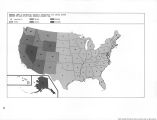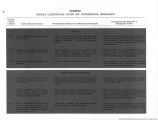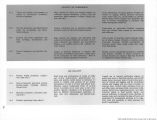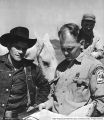| OCR Text |
Show to direct harvest pressure on public lands. If habitat management and wildlife population protection and enhancement are to be given the kind of increased emphasis and recognition in public land management that we recommend throughout this chapter, we believe the administering agencies will have to initiate much more effective programs to control hunter and fishermen dispersal and density. With permits being required, this type of control will be possible. Overcrowding of streamsides and lakes lowers the quality of the surroundings and the fishing experience. Over-concentration of hunters has the same effect on the quality of the experience and poses very high safety hazards as well. The need to secure hunting pressure in remote areas or areas where wildlife population is excessive will require specific programs, such as special bag limits worked out with the states. Standards for Cost-Sharing Recommendation 66: The states and the Federal Government should share on an equitable basis in financing fish and wildlife programs on public lands. Existing statutes provide no guidelines for the respective responsibilities of the states and the Federal Government for financing work done on public lands for fish and resident wildlife habitat improvement and for population surveys, control, and stocking. Generally, the states finance such programs on all lands, both public and private, with Federal assistance from the public land agencies on the lands for which they are responsible. However, the absence of guidelines in Federal law has led to inconsistencies in the sharing of costs in the various states with regard to work done on Federal public lands. Present cost-sharing practices vary with each land managing agency and with the different states that work with each agency. Some agencies share equally with the states in the cost of habitat work on Federal land. In some cases, states pay all of the cost of certain habitat work and fish restocking on Federal lands. For some time the Federal Government has provided general aid to all states to assist them in financing the cost of fish and resident wildlife work. Revenues from Federal excise taxes imposed on the sale of arms, ammunition, and fishing tackle are made available to all states to finance up to 75 percent of the cost of projects the states undertake for the benefit of fish and wildlife.13 These projects are undertaken on all classes of land ownership, including Federal lands. In recognition of the continuing role of both the states and the Federal Government relative to fish and wildlife on public lands, it is recommended that uniform cost sharing standards should be developed and applied for programs on all public lands generally open to hunting and fishing. Such standards should take into account the objectives of the Federal Government in contributing to fish and resident wildlife values through its land ownership programs, the 13 Provided under the Dingell-Johnson and Pittman-Robertson Acts, sometimes known collectively as the Federal Aid Program for Fish and Wildlife Restoration, 16 U.S.C. §§ 667-669b, 669c-669i and §§ 777-777k (1964). 173 |







































































































































































































































































































































































